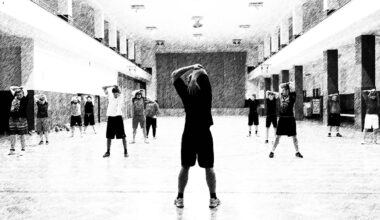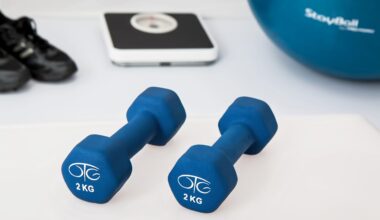Measuring Progress: Tracking Core Power Gains in Lacrosse Training
Lacrosse players need to develop impressive core power to enhance their performance on the field. A strong core provides stability and balance, essential traits for evading defenders and executing powerful shots. To evaluate core power gains, players can integrate various tracking methods into their training regimen. This approach enables athletes to measure improvements over time systematically. Moreover, understanding the connection between core strength and overall athletic performance can motivate players to maintain consistent training habits. Progress tracking should begin with setting specific core power goals. These might involve increasing maximum lifts in core-strengthening exercises or improving performance in functional movement patterns. Regular assessments can then be conducted using reliable metrics, such as measuring the duration of time spent in specific exercises or tracking changes in resistance levels. Additionally, employing technology such as fitness apps can aid in logging workouts and progress efficiently. This data can provide insights into the effectiveness of training routines, facilitating targeted adjustments. Engaging in collaborative discussions with coaches about core training effectiveness may also enhance the training experience for athletes. Keeping track of these gains is crucial for continual improvement.
While measuring core power gains, incorporating various exercises targeting this area is essential for lacrosse players. Effective exercises can help improve strength, endurance, and overall athletic performance. Popular core power workouts can involve traditional lifts, bodyweight exercises, and functional movements. Examples of these exercises include planks, Russian twists, medicine ball slams, and kettlebell swings. Each of these drills focuses on building strength and endurance in the core while engaging other muscle groups. Furthermore, dynamic movements contribute to a player’s agility and stability, both necessary for lacrosse. It’s essential to structure core workouts to include progressive overload, ensuring that players continuously challenge themselves to achieve improved performance. Utilizing circuit training can also be advantageous, allowing athletes to build core power while incorporating cardio elements. Importantly, rest and recovery play a critical role in building core strength and facilitating muscle repair. Sufficient recovery time enables muscles to recuperate and grow stronger, preventing potential injuries. By observing these principles during core training, lacrosse players can set a solid foundation for performance improvement. Enacting these strategies is crucial to attaining optimal results in core power development for lacrosse.
Utilizing Technology for Tracking Gains
Technology has become a vital tool in tracking core power gains for lacrosse players. With a variety of fitness apps and wearable devices, athletes can efficiently monitor their progress over time. Many apps allow users to upload workout data, providing insights into performance improvements and areas requiring more attention. Wearable devices like heart rate monitors and activity trackers can enhance training by supplying real-time feedback. This feedback can be crucial for understanding how different exercises impact heart rate and overall exertion. Moreover, video analysis technology enables athletes to review their techniques and movements, identifying areas for improvement. When players can visualize their form, they gain the ability to make necessary adjustments to enhance performance. Utilizing these technological advancements in training can help players stay motivated and engaged in their workouts. Ultimately, consistent tracking leads to better performance and well-informed adjustments to training routines. In addition, accessing benchmarks through technology can foster healthy competition among team members, further driving improvements. By integrating technology into core power training, lacrosse players gain a comprehensive understanding of their development.
Another effective method for tracking core power gains is through periodic testing and assessments. Regular assessments can provide a clear picture of an athlete’s progress and highlight areas that require further attention. Establishing a testing protocol can help players understand their core power benchmarks and how they improve over time. Testing might involve evaluating maximum repetitions in core exercises, timed performance, or analyzing recovery rates during strenuous workouts. By adhering to a consistent assessment schedule, players can establish an objective measure of their improvements. In some cases, assessments can even be used in conjunction with feedback from coaches to create tailored training programs aimed at maximizing core development. Engaging in both subjective and objective assessments can yield valuable insights into an athlete’s overall condition. Establishing a supportive environment during testing can add an element of motivation for athletes, encouraging them to push their limits. Involving teammates can foster a sense of community, enhancing overall training experiences. By conducting regular assessments, athletes stay accountable, making the process of tracking core power gains enjoyable and rewarding.
Sustaining Long-term Motivation
To maintain motivation while tracking core power gains, lacrosse players can implement various strategies. One effective tactic is to establish short and long-term goals that are both attainable and measurable. Short-term goals can provide quick wins, while long-term goals sustain motivation over time. Another method to bolster motivation is to celebrate achievements, no matter how small they may seem. Recognizing progress can help reinforce commitment to training. Athletes can also create a positive environment by surrounding themselves with similarly driven individuals, encouraging each other to stay focused. Participation in team training sessions allows for community support, promoting a shared commitment to improvement. Incorporating variety into training routines can also combat boredom, keeping workouts fresh and exciting. Players might enjoy exploring new exercises or fitness classes that stimulate their core power while challenging their overall fitness level. Engaging, fun, and diverse training experiences can help athletes sustain motivation throughout their development. Revisiting their fitness goals regularly and reflecting on their journeys can cultivate a positive mindset. These strategies ensure that athletes maintain enthusiasm as they work toward achieving core power gains within lacrosse training.
Educating athletes about the significance of core power in lacrosse performance is another vital aspect of maintaining motivation. When players understand the impact of core strength on their game, they are more likely to commit to their training routines with enthusiasm. Coaches and trainers can share relevant research and success stories that highlight the benefits of enhanced core power. Empowering athletes with knowledge helps them recognize the connection between effort and results. Also, providing opportunities for athletes to share their experiences can foster a sense of community and belonging. When players relate to each other’s journeys, they become more invested in their training. Encouraging players to engage in open discussions about their challenges and victories creates an inclusive environment. This supportive atmosphere enhances the overall training experience, inspiring athletes to push toward their goals. Additionally, motivational quotes and resources can provide a continual reminder of their aspirations. Fostering a passion for core strength and understanding its role in the overall sport can significantly increase players’ motivation. Consistent education surrounding core power will help athletes stay focused and committed to tracking their progress.
Conclusion: The Path Forward
In conclusion, tracking core power gains is pivotal in lacrosse training. By utilizing technology, executing regular assessments, and setting achievable goals, athletes can significantly enhance their core strength. Engaging in a variety of training techniques coupled with maintaining a supportive atmosphere can lead to great results. Athletes must remain informed about the impact of core power on their performance, encouraging a deeper commitment to their training regimens. This understanding fosters a culture of education and motivation, which ultimately promotes sustained success in the field. Collaboration with coaches and teammates ensures continuous progress while reinforcing athletes’ determination to excel. Moreover, the establishment of a tracking protocol can assist players in staying focused on their training objectives, solidifying the connection between effort and performance. As athletes experience improvements, celebrating achievements bolsters motivation and keeps them engaged in their fitness journeys. Ultimately, understanding the path to enhancing core power is essential for lacrosse players looking to improve their game. Commitment, education, and regular progress tracking must remain at the forefront of their training methodologies for sustained success.


